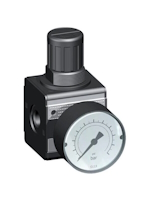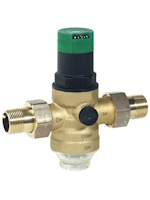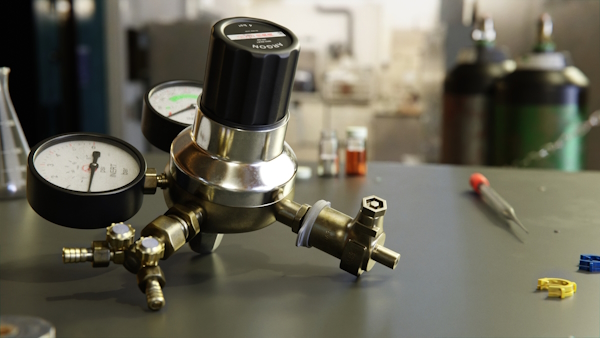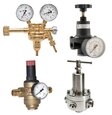How To Install a Pressure Regulator


Figure 1: An air pressure regulator (left) and water pressure regulator (right)
The correct installation of pressure regulators is critical to system performance and safety. These devices, crucial in managing and maintaining the desired pressure levels within air and water systems, play a pivotal role in industrial and residential settings. Air pressure regulators are typically found in compressed air systems, which stabilize the air pressure to tools and equipment, ensuring optimal performance and preventing damage. Water pressure regulators serve to maintain a consistent water pressure in plumbing systems, protecting pipes from pressure surges and reducing water wastage. This article guides the reader through installing air pressure regulators and provides valuable links for installing water pressure regulators.
View our online selection of pressure regulators!
Pressure regulator installation locations
Pressure regulators are suitable for a variety of applications. This section offers a few examples of applications for air and water pressure regulators and discusses where these regulators are used in the systems.
Air pressure regulator applications
Air pressure regulators are critical for controlling air flow in certain applications:
- Compressed air systems: Installed at the point where the air enters the system to ensure tools and machinery operate under constant pressure.
- Pneumatic control systems: Positioned within automation systems in manufacturing plants to regulate air flow for precise control.
- HVAC systems: Placed in ductwork or at the system's air inlet to maintain balanced air pressure for efficient heating, cooling, and ventilation.
- Medical equipment: Integrated into medical devices, such as ventilators, to provide controlled air pressure essential for patient care.

Figure 2: Pressure regulators are used in lab settings to ensure tools and machinery operate properly.
Water pressure regulator applications
Water pressure regulators are crucial for controlling water flow in various settings:
- Residential plumbing: Installed where the main water line enters the home to protect internal plumbing from high pressure and prevent leaks.
- Irrigation systems: Positioned at the main water source for the system to ensure even and efficient water distribution to all areas.
- Industrial processes: Utilized in facilities where water is used in manufacturing processes, installed at the point of water entry to regulate flow rates.
- Public water supply: Implemented within municipal water systems to manage the pressure distributed to the community, ensuring a safe and consistent water supply.
- RVs: Attached to the water inlet of recreational vehicles to safeguard onboard plumbing from varying pressures at different campgrounds, ensuring consistent, safe water flow.
Pressure regulator installation procedure
Water pressure regulator installation
To install a water pressure regulator, start by shutting off the main water supply and draining the existing water. The regulator is then installed onto the main water line, ensuring it's oriented in the correct direction as indicated by the manufacturer. For a more detailed walkthrough, including tools needed and troubleshooting tips, please explore our water pressure regulator replacement guide.
Air pressure regulator installation
Here's a detailed step-by-step overview of how to install an air pressure regulator:
- Identify the installation point: Determine the most effective location for the air pressure regulator, typically at the air compressor's outlet or before the air enters specific tools or machinery. This ensures the regulated air is delivered where it's most needed.
- Prepare the system: Before starting the installation, make sure the air supply is completely shut off to avoid any accidental discharge of compressed air. It's also important to release any residual pressure in the system to ensure a safe working environment.
- Inspect the regulator: Before installation, inspect the air pressure regulator for any damage or defects to ensure it's in good working condition. Pay attention to the flow direction marked on the regulator, which indicates the correct orientation for installation.
- Install mounting brackets (if necessary): If the regulator requires mounting brackets for installation, secure these to the wall or machinery as per the manufacturer's instructions. Ensure they are firmly in place to support the regulator's weight.
- Connect the regulator: Thread the regulator into place, aligning it according to the flow direction indicated. Use thread sealant on all threaded connections to prevent air leaks. Tighten the connections securely, but be careful not to over-tighten and damage the threads.
-
Secure the regulator:If the installation requires additional support, use the mounting brackets or clamps to secure the regulator firmly in place. This prevents any movement or vibration from loosening the connections over time.
- Some regulators should be installed with the glass display case facing away from the user. If there is some issue with the connection, a dangerously high input pressure can go into the regulator and blow off the case, potentially endangering personnel.
- Check for leaks: Once installed, slowly turn on the air supply and check all connections for leaks. Apply a soapy water solution to each connection; bubbling indicates a leak. Tighten any fittings as necessary to ensure airtight connections.
- Adjust the pressure: With the air supply on and the system pressurized, adjust the regulator to the desired pressure setting. Monitor the system's pressure gauge to ensure it stabilizes at the set pressure.
- Test the system: Operate the system as you normally would to ensure the regulator maintains the desired pressure during use. Make any necessary adjustments to the regulator to achieve optimal performance.
- Regular maintenance: After installation, include the air pressure regulator in your regular maintenance schedule. Check periodically for wear, leaks, or any signs of damage to ensure it continues to operate efficiently.
FAQs
Do I need to turn off water before installing a pressure regulator?
Yes, always turn off the main water supply to your home before starting the installation.
What maintenance is required for a pressure regulator?
Regularly check for leaks, and monitor water pressure. Replace the unit every 10-15 years or as needed.







